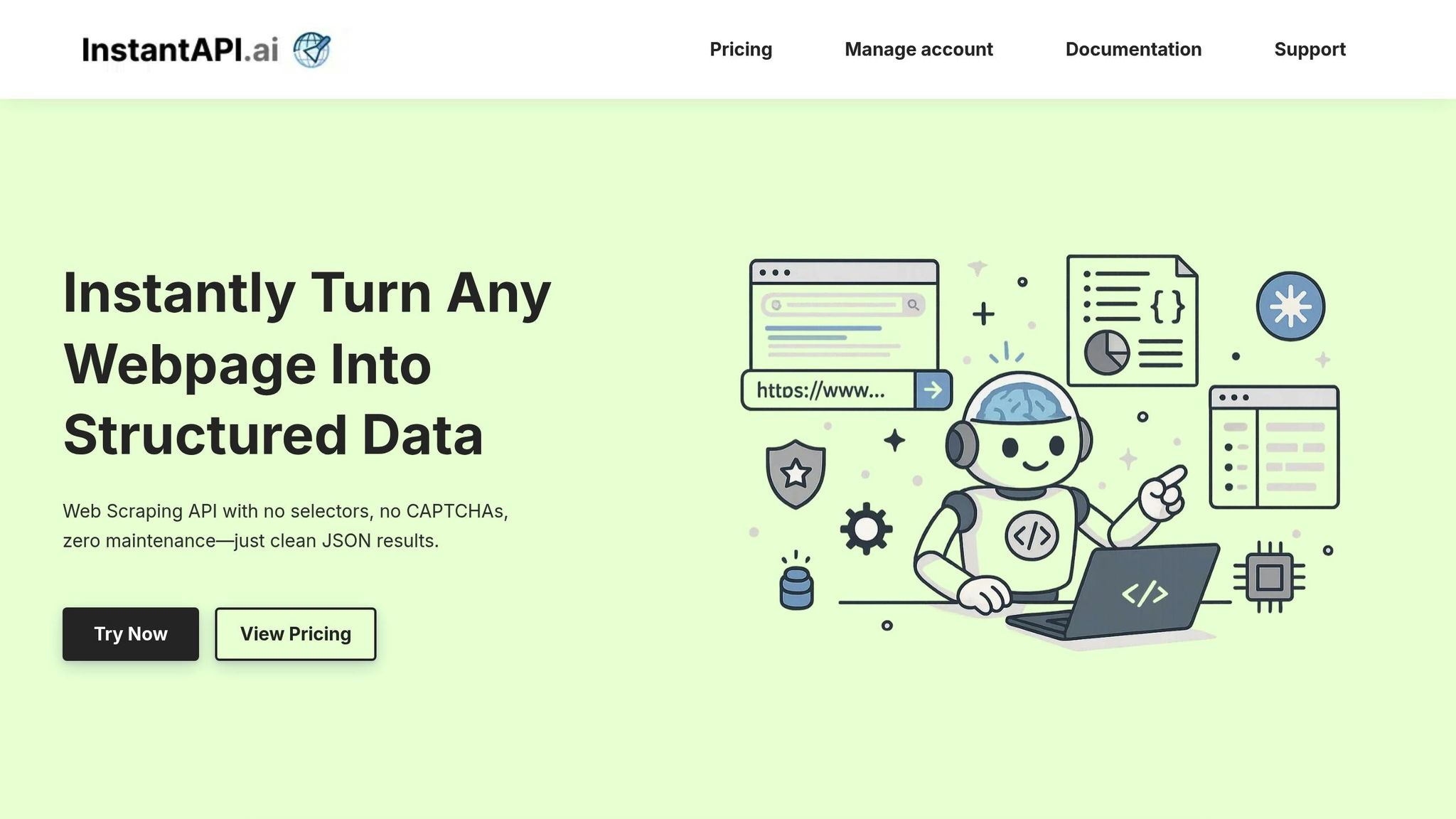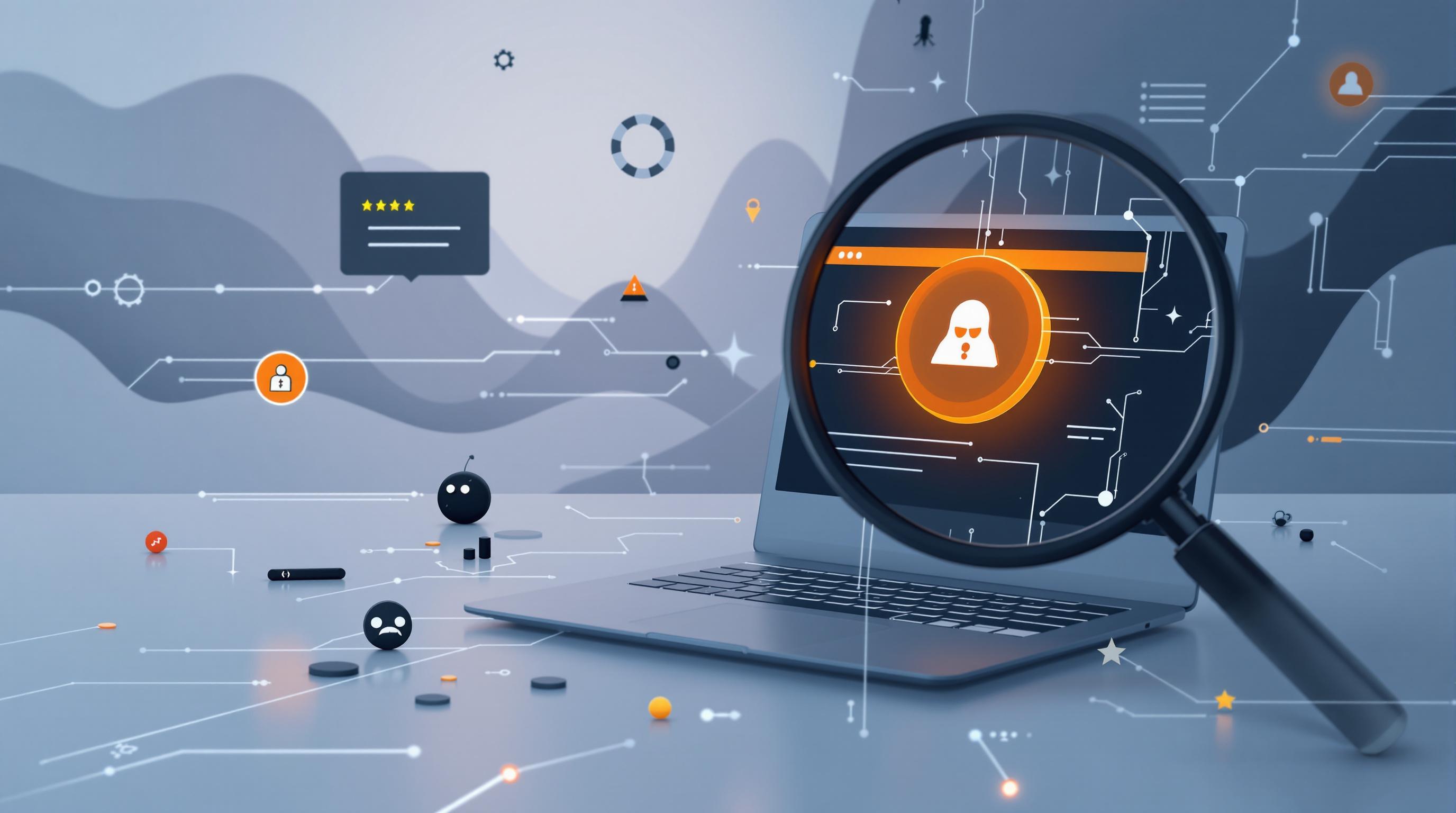Web scraping is changing how scientists collect and analyze environmental data. Here's why it matters:
- What is Web Scraping? It’s an automated way to gather data from websites, turning messy information into organized datasets for analysis.
- Why It’s Important: Scientists use it for real-time data on pollution, weather, and biodiversity to make informed decisions quickly.
- Key Benefits:
- Tracks air and water quality from multiple sources like EPA and AirNow.
- Monitors climate trends using tools like SASSCAL's WebSAPI.
- Studies species migration with platforms like eBird.
Tools Scientists Use
- Libraries: Scrapy, Beautiful Soup, Selenium.
- APIs: NOAA, EPA, and InstantAPI.ai ($2/1,000 pages scraped).
Guidelines for Ethical Scraping
- Follow website rules (robots.txt).
- Avoid scraping private or sensitive data.
- Validate data for accuracy and quality.
Web scraping enables scientists to track environmental changes, create better models, and make data-driven decisions.
Python AI Web Scraper Tutorial - Use AI To Scrape ANYTHING
Common Web Scraping Uses in Research
Web scraping has become an essential tool for researchers, especially in environmental science, where it helps gather and analyze vast amounts of data. Below are some key areas where web scraping plays a critical role.
Weather and Climate Data Collection
Scientists rely on web scraping to pull regional weather and climate data from trusted sources. A great example is the Southern African Science Service Centre for Climate and Land Management (SASSCAL)'s WebSAPI project. This open-source system uses R-based web scraping to extract a range of climate metrics, including temperature (°F), precipitation (inches), wind speed (mph), humidity percentages, and atmospheric pressure. By automating data collection, researchers can better understand and respond to climate trends.
Air and Water Quality Tracking
Web scraping allows for the automated collection of air and water quality data from multiple monitoring stations, offering a comprehensive view of environmental conditions. Key sources include:
- EPA's AirNow database for real-time air quality information
- State-level environmental protection agencies
- Local water quality monitoring systems
- Independent environmental monitoring stations
By pulling data from such a wide range of sources, researchers can analyze environmental health on both local and global scales.
"Web scraping is a powerful tool for environmental monitoring and analysis. By collecting and organizing data from various sources, it is possible to develop a comprehensive understanding of environmental conditions and track changes over time."
– Marquee Data
Species and Habitat Research
Tracking species and their habitats has become more efficient with web scraping. Platforms like eBird collect over 100 million bird sightings annually from citizen scientists, enabling researchers to map migration patterns and monitor habitat changes.
Another innovative example is Rainforest Connection, which combines web scraping with acoustic monitoring. Modified mobile phones installed in rainforests across countries like Cameroon, Ecuador, Peru, and Brazil detect illegal logging. The system scrapes and analyzes sound data in real time, identifying noises such as chainsaws and trucks.
"Online digital data, such as social media data, can be used to strengthen existing assessments of the status and trends of biodiversity, the pressures upon it, and the conservation solutions being implemented, as well as to generate novel insights about human-nature interactions."
– Dr. Andrea Soriano-Redondo
Web Scraping Tools for Scientists
Environmental scientists are increasingly turning to tools that simplify the process of extracting and analyzing web data. These tools help streamline the technical aspects of data collection, making research more efficient and accessible.
InstantAPI.ai Data Collection Features

InstantAPI.ai offers a user-friendly API designed for efficient data collection. Its pay-per-use pricing model - $2 for every 1,000 web pages scraped - makes it a budget-friendly option for projects of all sizes. Some standout features include:
- Automated extraction of structured web data
- Built-in pagination handling for working with large datasets
- Integration with search results for more thorough data collection
- Real-time data processing for immediate insights
This platform provides tailored APIs, but many scientists also rely on established programming libraries to meet a variety of scraping needs.
Common Research Libraries
Here are some popular libraries frequently used in environmental research:
| Library | Primary Use Case | Weekly Downloads | Key Feature |
|---|---|---|---|
| Scrapy | Large-scale data extraction | 304,000 | A robust framework for comprehensive scraping |
| Beautiful Soup | HTML parsing | 29,000,000 | Flexible parsing of HTML and XML |
| Selenium | Dynamic content scraping | 4,700,000 | Browser automation for extracting dynamic data |
Research API Integration
In addition to standalone tools, combining multiple APIs can significantly enhance data collection efforts. Agencies like the National Oceanic and Atmospheric Administration (NOAA) and the Environmental Protection Agency (EPA) provide APIs that offer access to:
- Real-time air quality data
- Historical weather records
- Soil composition details
- Vegetation indices, such as NDVI
- Greenhouse gas emission statistics
"APIs enable these synergies by letting developers easily access and combine digital assets in different systems, even if those systems were never intended to interoperate." – Google, State of API Economy 2021 Report
sbb-itb-f2fbbd7
Web Scraping Guidelines for Scientists
Using the right tools is just the beginning. To ensure data accuracy and maintain ethical standards, scientists need to follow clear guidelines. These practices safeguard data quality while respecting the boundaries of online resources.
Legal and Research Ethics
Navigating the legal landscape of web scraping can be tricky. The 2019 LinkedIn v. hiQ Labs case confirmed that scraping publicly accessible data is legal, but researchers still need to follow specific rules:
- Check the website's robots.txt file for guidance.
- Obtain permissions for accessing restricted or sensitive data.
- Properly credit data sources in your research.
- Avoid collecting personally identifiable information (PII).
Key Compliance Requirements:
| Requirement | Description | Impact on Research |
|---|---|---|
| Terms of Service | Review website usage policies | Determines what data can be scraped |
| Data Protection | Adhere to GDPR and CCPA guidelines | Influences how data is stored and used |
| Fair Use | Apply research exceptions | Allows limited use of copyrighted material |
Data Quality Standards
Bad data can be expensive - studies show it costs organizations about $13 million annually. For environmental scientists, ensuring data quality is critical to maintaining research credibility. Here are some essential steps to validate your data:
- Cross-check your findings with trusted environmental databases.
- Use automated tools to flag irregularities.
- Keep detailed logs of your validation processes.
- Conduct periodic spot-checks to catch potential errors.
Technical Best Practices
Once you’ve established solid quality standards, it’s time to focus on technical execution. For example, a study analyzing 46,366 URLs achieved a 91% valid return rate by applying these strategies:
-
Request Management
Use rate limiting to prevent overwhelming servers. Tools like InstantAPI.ai simplify this with built-in throttling features. -
Error Handling
Set up comprehensive error logging and recovery systems to manage unexpected issues. -
Resource Optimization
Limit scraping depth - stopping at three levels often captures the most relevant data while reducing server strain.
"In web scraping, ethical and efficient practices are the pillars of progress. Handle the data environment with integrity, privacy understanding, and an unwavering commitment to excellence. Web scraping best practices not only drive innovation but also shape a sustainable and responsible digital future." - Saurabh Bhardwaj, VP, Account Management
Finally, thorough documentation is essential. Keep detailed records of your scraping process, including:
- Criteria for selecting data sources
- Steps taken to validate data
- Methods for handling errors
- Quality control protocols
Good documentation not only ensures reproducibility but also supports future research endeavors.
Conclusion: Web Scraping Impact on Science
Web scraping has reshaped the way environmental scientists gather and interpret data, introducing a new era of data-driven research and streamlined methodologies. A great example of this is the NYC Stewardship Mapping and Assessment Project (STEW-MAP), which analyzed data from 78 environmental organizations, showcasing the power of systematic data collection. This shift has opened doors to dynamic monitoring and more detailed environmental evaluations.
Today, environmental scientists rely on web scraping to monitor ecosystem changes, analyze climate trends, and track air quality in urban areas. Using methods like iEcology, researchers pull data from platforms like Google Trends, news outlets, and social media to study species behavior and environmental characteristics.
"Web scraping has emerged as a valuable asset for organizations striving to enhance their sustainability efforts. By harnessing the power of data extraction, businesses can gain valuable insights, drive informed decision-making, and implement sustainable practices across their operations and supply chains." - Gabriela Vázquez
The measurable impacts of web scraping are evident across several research areas:
| Research Area | Impact | Measurable Outcome |
|---|---|---|
| Climate Analysis | Real-time data from diverse sources | Improved accuracy in weather pattern predictions |
| Biodiversity Monitoring | Automated tracking of species populations | Broader and deeper ecosystem assessments |
| Air Quality Research | Continuous monitoring of pollution levels | Pinpointing pollution hotspots for focused interventions |
These advancements highlight how transforming raw web data into structured, actionable insights is driving smarter, evidence-based decisions and policies in environmental science.
FAQs
How can environmental scientists ensure their web scraping practices are ethical and legally compliant?
Environmental scientists can responsibly use web scraping by adhering to ethical and legal guidelines. Start by carefully reviewing the terms of service (ToS) of the websites you plan to scrape. These terms often clarify whether scraping is allowed and under what conditions. Ignoring them could lead to legal trouble.
It's also important to follow ethical practices like implementing rate limiting to avoid overloading the website's servers, which helps minimize disruptions. Whenever feasible, seek permission from data owners to promote trust and transparency. Additionally, ensure compliance with privacy laws such as the California Consumer Privacy Act (CCPA) and the General Data Protection Regulation (GDPR), both of which emphasize protecting personal data.
By combining effective technical methods with a commitment to ethical standards, environmental scientists can seamlessly and responsibly incorporate web scraping into their research.
What are the best tools for web scraping in environmental research, and how do they differ in functionality?
Environmental scientists often turn to various web scraping tools to collect and analyze data efficiently. Among the most popular choices are Scrapy and Beautiful Soup. Scrapy, a Python framework designed for large-scale projects, is known for its speed and ability to handle complex workflows. Meanwhile, Beautiful Soup is perfect for smaller tasks, offering simplicity and ease when parsing HTML or XML.
When dealing with websites featuring dynamic content, tools like Selenium come into play. Selenium can interact with JavaScript-driven pages, making it invaluable for scraping such sites. Similarly, Puppeteer and Playwright are widely used for managing headless browsers, which are particularly useful in advanced scraping situations. Each tool has its niche: Scrapy shines in detailed, large-scale projects, Beautiful Soup is ideal for quick and simple tasks, and Selenium, Puppeteer, or Playwright are essential when handling JavaScript-rendered content.
How does web scraping improve climate and biodiversity research compared to traditional methods?
Web scraping plays a crucial role in advancing climate and biodiversity research by allowing scientists to gather large volumes of real-time data from sources like government databases, scientific publications, and environmental monitoring platforms. This automated method outpaces traditional manual data collection, which can be slow and error-prone.
With access to up-to-date information on climate patterns, pollution levels, and species distributions, researchers can conduct more precise and thorough studies. Web scraping also enables continuous monitoring, making it easier to track environmental changes and adjust conservation strategies accordingly. This approach streamlines data collection while ensuring the information is current and dependable.


